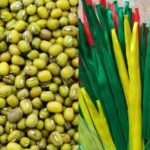Growing sprouts at home is a popular hobby, especially among homemakers, as sprouts offer a plethora of health benefits for women. So, how can you easily grow sprouts at home with just a basket? Read on to find out!
1 Popular Types of Sprouts
Sprouts are young, growing plants that are typically small in size (around 4-10cm). They are grown and harvested within a short period and are generally easy to grow and require minimal care.
Nowadays, sprouts are a popular choice and are favored by many. Some of the most common types include:
Brassica Sprouts
 Brassica sprouts
Brassica sprouts
Brassica sprouts, scientifically known as Brassicaceae, encompass various soft vegetables from the brassica family, such as bok choy, mustard greens, bitter melon, and spoon mustard. They are easy to grow and care for, with a harvest time of only 5-7 days.
White Radish Sprouts
 Nutritious white radish sprouts
Nutritious white radish sprouts
White radish sprouts are a nutritious option, packed with vitamins such as , , , and more, as well as beneficial minerals like , , and . Interestingly, the vitamin A content in white radish sprouts is ten times higher than that of carrots.
Broccoli Sprouts
 Broccoli sprouts with multiple health benefits
Broccoli sprouts with multiple health benefits
Broccoli sprouts are a rich source of , which help prevent and inhibit cancer cell activity while enhancing metabolism and promoting healthy skin.
Legume Sprouts (Soybean Sprouts)
 Popular legume sprouts
Popular legume sprouts
Legume sprouts, including soybean sprouts, are the most common type of sprouts. They encompass a group of sprouts from the legume family, such as red beans, green beans, black beans, and soybeans. Legume sprouts are characterized by their large stems, resistance to pests and diseases, and rapid growth, making them ideal for large-scale cultivation.
Water Spinach Sprouts
 Water spinach sprouts
Water spinach sprouts
Water spinach sprouts offer numerous “miraculous” health benefits. Due to their sweet taste and cold nature, they help cool the body and detoxify. Additionally, their high nutritional value makes them ideal for nourishing patients, especially those with chronic anemia.
2 How to Grow Sprouts Using a Basket and Cotton Wool
Preparation:
Sprout seeds: These are typically sold in packets priced at 10,000-20,000 VND per packet, depending on the variety. Choose the type that suits your preferences and needs.
Growing equipment: A basket with a diameter of approximately 30cm
Cotton wool: You can purchase long strips of cotton wool or repurpose baby nursing pads.
Growing Process:
 Soaking the seeds
Soaking the seeds
Before planting, soak the seeds in warm water (around 50 degrees Celsius) for 6-7 hours. Then, remove any seeds that float to the surface, as these are likely empty or infested.
 Sowing the seeds
Sowing the seeds
Before sowing the seeds, remember to soak the cotton wool in water and line the basket with it.
Next, remove the seeds from the water and sow them densely in the basket. You can use a 20g packet of seeds for a 30cm diameter basket.
Finally, water the sown seeds once more.
Note: When sowing the seeds, place a basin under the basket to collect excess water.
Step 3 Caring for the Sprouts
 Watering the sprouts to ensure their growth and development
Watering the sprouts to ensure their growth and development
Sprouts germinate best at moderate temperatures between 25-30 degrees Celsius and thrive in enclosed, dark spaces. Therefore, it is advisable to place the basket of sprouts in a corner or a room to maximize yield.
Sprouts growing in cotton wool require minimal water, so watering them once a day is sufficient.
Step 4 Harvesting
 Cutting the sprouts in clusters
Cutting the sprouts in clusters
After 5-6 days, when the sprouts have grown to a height of about 10cm, they are ready for harvest. Simply cut them in clusters with a pair of scissors.
3 How to Grow Sprouts Using a Basket and Soil
Preparation:
Sprout seeds: Opt for seeds with a clear origin to ensure quality and safety. There are numerous varieties to choose from, such as white radish, green beans, bok choy, water spinach, black beans, and more.
Growing Equipment:
A basket with numerous holes for drainage.
Lining Paper: Use soft paper, such as tissue paper.
Cardboard: Cut a piece of cardboard to fit the shape of the basket. This will be used to cover the basket of seeds.
Soil: Prepare a nutrient-rich soil, such as organic soil, Tribat soil, or soil mixed with coconut coir.
Growing Process
Soak the sprout seeds in warm water for 6-8 hours, then wrap them in a cloth for another 10-12 hours. Afterward, discard any damaged or empty seeds and let the remaining seeds air dry.
 Soaking the seeds
Soaking the seeds
 Sowing the seeds
Sowing the seeds
Before sowing, line the basket with a layer of soft paper and lightly spray it with water to moisten it. Then, sow the seeds on the prepared surface at a density of approximately 10g per 40cm2 of growing media. Water the seeds again and cover the basket with the cardboard. Leave it undisturbed for two days.
 Watering the sprouts
Watering the sprouts
Spray the sprouts with water twice a day, in the morning and evening, using a fine mist. Keep the basket covered during the initial two days of germination to stimulate sprout growth.
Avoid placing the basket of sprouts in direct sunlight.
 Harvesting the sprouts
Harvesting the sprouts
After 5-7 days, the sprouts will have grown to a height of 8-12cm, and you can harvest them by cutting them in clusters with scissors.
In conclusion, these are our tips for easily growing sprouts at home using just a basket. We hope that you found this information helpful and that it inspires you to grow your own fresh and nutritious sprouts!

































